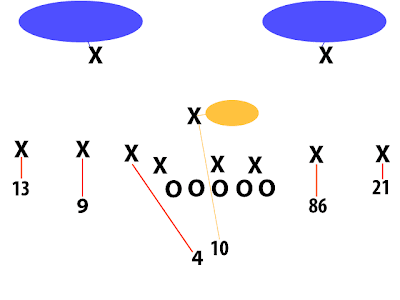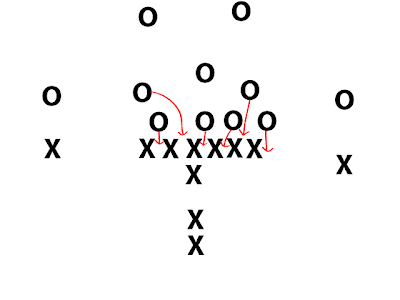Everyone knew Michigan was going to struggle this year. Maybe nobody thought the Wolverines would fall to Toledo, but everyone except the most fanatically-blind Michigan supporters knew that a Big Ten title was likely out of the question, and a bowl game might be a reasonable goal. There was always the future to look forward to. A year of learning under the spread system. A year of Barwis. A good 2009 recruiting class. The future was looking bright, because Michigan fans certainly weren’t planning to bail after one trying year under Rich Rodriguez. The members of that 2009 recruiting class, on the other hand? Some may not stick around to help clean up the carnage.
There are competing schools of thought on the link between winning and success on the recruiting trail. On one hand, you have the fans who hope prospects see the opportunity to come in and compete right away (and, realistically, some recruits do follow this train of thought). On the other side, one can find those who think a recruit will want to stay as far away as possible from anything that could be perceived as a “sinking ship” (again, some recruits think this, as well).
I personally think, from my trials and tribulations in following recruiting, that there is something of a hybrid between these two schools of thought. We’ll start when a recruit is young. If a child grows up watching a program succeed regularly, he might become something of a fan of that program. More likely, however, it may become “familiar” to him, if only on the most shallow name-recognition basis. Actual wins and losses (of course, except in the case where a recruit grows up a diehard fan of a certain program) probably don’t really become a factor until a high schooler becomes something of a potential recruit. Once a young man realizes that he might have an opportunity to play division 1 football (brother), the attention becomes a little more focused on the programs who might be potential destinations. This typically happens around a prospect’s junior year.
Senior year, however, is not likely a time for recruits to radically alter their perceptions of a program. If a team struggles during the 2008 season (this is completely hypothetical, of course), a young quarterback from San Diego or Wichita Falls (again, completely hypothetical, and I randomly selected those cities) will see that as an opportunity to come in and compete for a starting position right away. This is especially true of those hypothetical recruits who intend to hypothetically enroll early hypothetically. Hypothetically. Only the more loosely-committed players, or those who look at depth charts and realize that, although there is playing time up for grabs, it is not at their position, are the ones who might be swayed from the 2009 class.
So, who might fall into the category for this class? Bryce McNeal, Brandin Hawthorne, Anthony Fera, and DeWayne Peace have taken or plan to take visits elsewhere, along with former commitment William Campbell. DeQuinta Jones has been heard from very little since he committed, and his status is a virtual mystery to Michigan fans. As long as Michigan’s coaches continue to do a good job recruiting these players, they should retain those that they want. McNeal seems to be the most likely to decommit at this time.
So, let’s bring this back to the 2010 recruiting class. If high school juniors see a program lose, and form their perception from that, it means Michigan’s 2010 class could be pretty bad, right? Well, yes and no. Michigan already has 2 commits, both of whom are likely to be 4-star or 5-star prospects. A third is presumably on the way, another 4-star or better player. All three of these players have Michigan ties from long before their junior years of high school, and their perception of the Wolverines isn’t bound to change radically. Joining a class of highly-ranked prospects is one of the antidotes to a less-than-stellar year. Jeremy Jackson, Ricardo Miller, and hopefully Marvin Robinson all will be an incentive for other good recruits to join the class.
This may be one of the factors in some of the more inexplicably-good recruiting classes in recent memory. Notre Dame can sell its tradition, but one would think a 3-9 year would deter top prospects from joining the class of 2008 in South Bend. At the end of the day, however, the Irish finished with the #2 class in the nation. The only team that finished ahead of the Irish? Alabama, a team that had a recent history of mediocrity, despite its history. Nick Saban, in his second year in Tuscaloosa, and coming off a 7-6 record that didn’t exactly scream “WOO PROGRAM ON THE RISE” pulled in a stellar group of players to help turn the Tide’s fortunes around.
So, can Michigan, with its young, exciting coach pull in top classes in 2009 and 2010, despite a 2008 season that will likely end well below .500? The recruits aren’t stuck with Michigan, but we fans are hoping that Rich Rod can keep the snake oil flowing.
Posted under Coaching, Recruiting
Comments Off on Fallout?




 Michigan is on the right hash in a basic spread set. Brandon Minor is the running back to Steven Threet’s left. Greg Mathews and Junior Hemingway are the wideouts to the left and right, respectively. In the left slot is Martavious Odoms. At slot on the right side is tight end Kevin Koger, appearing in a game for the first time this year. Wisconsin counters with a 3-2-6 dime package. The four CB/Nickel players are head up over the receivers. The linebackers are head up over Threet and Minor. The two safeties are deep.
Michigan is on the right hash in a basic spread set. Brandon Minor is the running back to Steven Threet’s left. Greg Mathews and Junior Hemingway are the wideouts to the left and right, respectively. In the left slot is Martavious Odoms. At slot on the right side is tight end Kevin Koger, appearing in a game for the first time this year. Wisconsin counters with a 3-2-6 dime package. The four CB/Nickel players are head up over the receivers. The linebackers are head up over Threet and Minor. The two safeties are deep. At the snap, Threet takes a 3-step drop. Minor sets as though he’s pass blocking, though Wisconsin only comes on a three-man rush. Free of the duty of protecting Threet, Minor runs a short circle route out of the backfield. Odoms runs a 10-yard stop route. The other three receivers all run vertical routes, with Mathews and Hemingway on fly routes down the sideline, and Koger running a seam down the middle.
At the snap, Threet takes a 3-step drop. Minor sets as though he’s pass blocking, though Wisconsin only comes on a three-man rush. Free of the duty of protecting Threet, Minor runs a short circle route out of the backfield. Odoms runs a 10-yard stop route. The other three receivers all run vertical routes, with Mathews and Hemingway on fly routes down the sideline, and Koger running a seam down the middle.
 Wisconsin rushes the three linemen, runs man coverage on the receivers (and backs, including a spy on Threet), and has two safeties taking deep halves over the top. Threet goes deep to Koger, who is behind his defender. Koger makes the catch at the 6, and isn’t hit by a safety until after he’s in the endzone.
Wisconsin rushes the three linemen, runs man coverage on the receivers (and backs, including a spy on Threet), and has two safeties taking deep halves over the top. Threet goes deep to Koger, who is behind his defender. Koger makes the catch at the 6, and isn’t hit by a safety until after he’s in the endzone.

